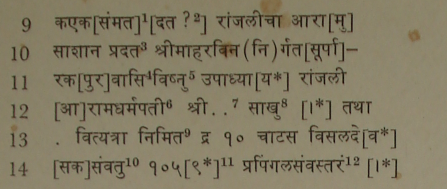|
The Indian Analyst
|
North Indian Inscriptions |
INSCRIPTIONS OF THE SILAHARAS OF NORTH KONKAN
TRANSLATION ..Success! Hail ! May there by victory and prosperity! .. In the expired year ten hundred [increased by seventy]—(in figures) 10[70]13—by the era of the Śaka king, during the victorious reign of the Mahāmaṇḍalēśvarādhipati, the illustrious Haripāladēva, an orchard at Rānjalī in the western part of the seashore, which is situated in Śūrpāraka-Two Thousand, has been granted by a royal charter with the approval of all people headed by the illustrious Dēvalanāyaka. Vishṇu Upādhyāya, who has emigrated from Māhara and is (now) staying at the town of Śūrpāraka is the religious owner of the orchard at Rānjalī. The illustrious…is the witness.
..For (his) maintenance 10 drammas were donated by Chāṭasa Visaladēva in the Śaka year 105[9][14], the (cyclic) year being Prapiṅgala[15]. No. 25 : PLATE LXIII ..THIS inscription was first very briefly noticed by Pandit Bhagvanlal Indraji in the Bombay Gazetter (old ed.), Vol. I, part ii, p. 19, f. n. 3. It was later edited without a facsimile by Dr. H.D. Sankalia and S.C. Upadhyaya in the Epigraphia Indica, Vol. XXIII, pp. 273 f. It was later included by Dr. S. G. Tulpule in his Prāchīna Marāṭhī Kōrīva Lēkha, pp. 48 f. and plate. It is edited here from an ink estampage kindly supplied by the Chief Epigraphist.
..
The stone bearing this inscription was found near Āgāshī in the Bassein tālukā of the
Ṭhāṇā District. It measures 2’ 8½” (82. 55 cm.) by 1’ 4½” (41.91 cm.). The record consists of
16 lines and occupies a space 14” (35.56 cm.) by 16½” (41.91 cm.). It may have lost one or
two lines at the bottom. The average size of the letters is ¾” (1.90 cm.). Below the inscribed [1] Dikshit reads हस्तोदकसहिता भुवं, and Tulpule लोक एकसंमतीं भुत्व, but the aksharas are indistinct here.
|
|||||||||||||||||||||||||||||||||||||||||||||||||||||||||||||||||||||||||||||||||||||||||||||||||||||||||||||||||||||
| > |
|
>
|








